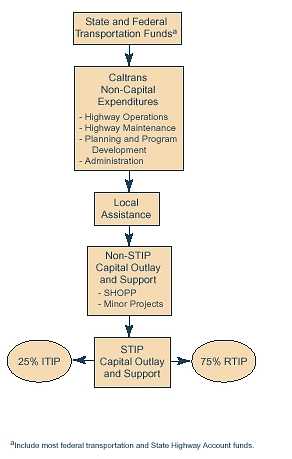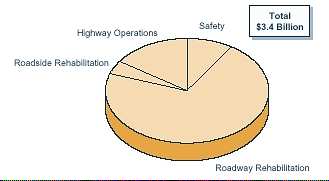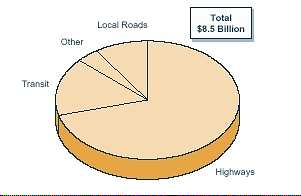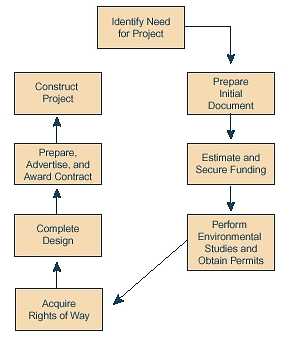
| The Key Players: Who Decides What Gets Built and When? |
|
| State | |
| Legislature |
|
| Department of Transportation (Caltrans) |
|
| California Transportation Commission (CTC) |
|
|
Regional
|
|
| Regional Transportation Planning Agency (RTPA) |
|
| Metropolitan Planning Organization (MPO) |
|
|
Other |
|
| Other Players |
|

• The "STIP" (State Transportation Improvement Program) process determines which transportation projects will be funded by state funds and when projects will be constructed. The process works as detailed below.
• Caltrans first prepares a fund estimate which projects biennially all federal and state transportation funds available over a four-year period. The fund estimate, when adopted by the CTC, provides the basis for determining how many transportation projects can be funded in that time frame.
• For the four-year period from 2000-01 to 2003-04 (the 2000 STIP period) federal funds, other than transit-specific funds, and SHA funds are projected to total $19.8 billion.
• These funds are first used to cover noncapital expenditures, including administration, highway maintenance, and operations. Remaining funds are then allocated to local assistance and capital outlay.
How Are STIP Funds Distributed?
• Under current law, 75 percent of STIP funds are designated for the Regional Transportation Improvement Program (RTIP) with projects chosen by RTPAs, while the remaining 25 percent are designated for the Interregional Transportation Improvement Program (ITIP) with projects chosen by Caltrans. Projects may also be jointly funded by the ITIP and the RTIP.
• Chapter 622, Statutes of 1997 (SB 45, Kopp) created the current structure for decision-making and distributing STIP funds. Chapter 622 consolidated transportation programs into two basic categories—regional and interregional.
How Are Interregional Funds Distributed?
• Of the ITIP funds, 40 percent is subject to the "north_south split" (discussed below), while the remaining 60 percent is limited to improvements outside urbanized areas.
• About 10 percent of ITIP funds must be programmed for intercity rail projects, while the remainder may be programmed for highway improvement projects.
How Are Regional Funds Distributed?
• Funds for the RTIP are geographically divided by what is known as the north-south split. Specifically, 60 percent of funds are allocated to 13 southern counties, while the remainder is allocated to the remaining 45 northern counties.
• These funds are further divided into county shares based on a statutory formula which allocates 75 percent of the funds based on population, and 25 percent based on highway lane miles.
How Are Projects Chosen for the Regional Program?
• Projects are selected for funding by RTPAs based on regional priorities, as defined in the 20-year regional transportation plans. Specifically, projects are selected from a large pool of projects proposed by cities, counties, and transit agencies. The RTPAs then submit their respective lists to the CTC for approval.
• The CTC can either adopt or reject an individual RTIP in its entirety, but cannot delete or add specific projects. Together, the 46 regional proposals form the statewide RTIP.
Noncapital Expenditures
• Caltrans estimates approximately $5.1 billion in noncapital expenditures
during the 2000 STIP period (2000-01 through 2003-04).
• The 2000-01 budget proposes to spend about $885 million in state
and federal money on highway maintenance and operations.
Local Assistance
• Certain state and federal funds flow through Caltrans to local agencies
for nonhighway projects such as expansions of local roads or transit improvement.
• Caltrans estimates that about $4 billion will be spent on local
assistance in the 2000 STIP period.
Capital Outlay Expenditures
• Capital expenditures involving state funds are estimated and scheduled
in two four-year documents, prepared by Caltrans and regional agencies and adopted
by the CTC every two years:
• The State Highway Operation and Protection Program (SHOPP): Includes
schedule and cost-estimates for all highway rehabilitation projects, as well
as projects to improve safety and operations.
• The State Transportation Improvement Program (STIP): Includes schedule
and cost estimates for projects that add capacity, such as expanding
a freeway or adding an additional train.
• Current law requires that highway funds first be spent to preserve the
highway system before being used to expand it. This requires that the SHOPP
is fully funded before determining the availability of funds for the STIP.
• The State Highway Operation and Protection Program (SHOPP) primarily funds rehabilitation projects including roadway (pavement) and roadside (landscape and other nonpavement facilities) rehabilitation.
• For the four-year period from 1998-2002, about $3.4 billion is programmed for SHOPP projects. About 72 percent of the SHOPP expenditures will be for pavement rehabilitation.
• The SHOPP is based on a ten-year plan (updated every two years) that projects state highway rehabilitation needs.
• The SHOPP projects are selected by Caltrans based on statewide need,
rather than a geographic formula, such as percentage of population or highway
lane miles.

• The current 1998 STIP contains almost $8.5 billion worth of projects over a six-year period (1998-99 through 200304), including projects that were incorporated from earlier STIP cycles. The 2000 STIP, the first four-year STIP under current law, covers the period 2000-01 through 2003-04 and will be adopted in the summer 2000.
• Funding for STIP projects is scheduled in four discrete categories: engineering and design (known as capital outlay support), environmental review, right-of-way acquisition, and construction.
• For the 1998 STIP, 70 percent of funds are spent
on highways, 16 percent on transit, and 10 percent on local roads.
The remaining 4 percent (other) consists primarily of projects that are
designed to improve air quality, such as constructing carpool lanes or converting
transit fleets to clean fuel.

• While STIP funds are distributed according to a formula based on population and highway lane miles, SHOPP funds are distributed according to need.
• As a result, some counties receive substantially more STIP funds than SHOPP funds, such as San Diego and Los Angeles Counties, while the reverse is true for other counties, such as Nevada and Siskiyou.
Long-Term Transportation Planning
• The first step to solving transportation problems occurs at the transportation
planning phase.
• State and federal law require that every region with a population of
50,000 or more prepare and regularly update a 20-year Regional Transportation
Plan (RTP). This plan • Any project that is expected to have a negative air quality impact must
be included in the RTP. This ensures that the project's air quality impact is
accounted for in the evaluation of a region's ability to meet state and federal
air quality standards.
• The RTP must be approved by the Federal Highway Administration (FHWA),
the Federal Transit Administration, and must be consistent with the State Implementation
Plan (SIP) for air quality conformity with the federal Clean Air Act before
a project is eligible for federal funding.
Secure Funding for Project
• Once a project has been included in the RTP, its sponsor (such as a
city, county, or transit agency) must secure funding for the project from any
combination of state, federal, local, or private fund sources.
• For projects built with state funds, funding is secured when a project
is programmed in the STIP; for projects built with federal funds, but no state
funds, projects must be included in the federal equivalent, known as the Federal
Transportation Improvement Program (FTIP).
Environmental Review
• Before extensive design or construction can begin, FHWA, Caltrans, or
local agencies are responsible for ensuring that the project complies with state
and federal environmental laws. The two major laws affecting transportation
projects are the California Environmental Quality Act (CEQA) and the National
Environmental Protection Act (NEPA). These laws require that various alternatives
be examined in order to meet the purpose and need of the project while minimizing
the project's negative environmental impact.
• Typically, environmental review is the longest and most unpredictable
phase of the project delivery process. The review can include:
• Technical studies which in some cases can only be conducted at a particular
time of the year in order to evaluate the potential impact.
• Project evaluation and permit approval by as many as 15 to 20 agencies
on certain projects.
• Public hearings which may result in requests to review new alternatives
or eliminate the project altogether.
Design
• Due to restrictions in the State Constitution, almost
all state highway projects funded with state funds are designed by Caltrans.
For state highway projects funded without state funds—such as those funded
with only local and federal revenues—design may be performed by local transportation
agency staff or local agencies may contract out to the private sector.
• Although preliminary design must be done in order to conduct environmental
review, final design work is not completed until the project has received environmental
approval by the various state and federal agencies.
Construction
• Once rights-of-way have been purchased and design completed, Caltrans
or local agencies advertise the project for construction by the private sector.

identifies the transportation needs of the region based on projections of growth
and travel demand, coupled with projections of estimated funding levels.